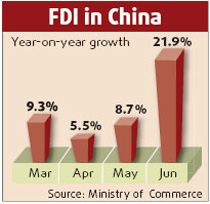Yi Xianrong
Recent figures released by the National Bureau of Statistics show the country's consumer price index (CPI) rose 3.2 percent in the first half of the year, and increased 4.4 percent in June.
Hikes to food prices largely powered the bulging CPI, while prices of manufactured goods and services remained stable.
In view of this, no overall price rises are expected if everything is handled properly. However, if the food price increases fail to be brought under control and are compounded by quickly rising real estate prices, the CPI could go up sharply.
Some, following the lines of developed nations' practice, argue that the CPI is staying basically stable, judging from the core CPI, which excludes food and energy costs.
People of this school of thought ignore the fact that there is a wide gap between the Chinese CPI system and that of developed market economies. It has no real meaning that they gauge the Chinese reality with experiences gained in the developed world.
The Chinese CPI consists of eight primary components covering food, clothing, home facilities, services, healthcare, transportation, communications, entertainment, education and housing.
The weight of food accounts for 34 percent of the CPI, while entertainment, education and stationary account for 14 percent, housing 13 percent, transportation and communications 10 percent, healthcare 10 percent, clothing 9 percent, home facilities and their maintenance 6 percent and wine, cigarettes and daily-use articles 4 percent.
The US CPI system, however, is weighted differently. Housing, for example, accounts for 42.1 percent, food and drinks 15.4 per cent, transportation 16.9 percent, medicare 6.1 percent, clothing 4 percent, entertainment 5.8 percent, education 5.9 percent and other commodities and services 3.8 percent.
Apart from the different weight of CPI components, the definition and revision of the weights of commodities and services in the Chinese CPI are not conducted in a transparent way. In contrast, the weights of commodities and services in the US CPI, are defined on the basis of surveys on the spending of millions of households over the last couple of years. Moreover, these weights are revised every other year so that they keep up with changes in consumer tastes and preferences.
In China, the system of drawing up the CPI was introduced as early as the 1950s during the planned-economy era. As a result, the data and experience gained during this period are largely disconnected from those gained after the late 1970s when the country embarked on the road of reform and opening up.
Moreover, profound changes have taken place in the country's economic set-up and climate over the last three decades. In this context, the CPI draw-up trails new developments - and its accuracy is questionable.
The current CPI calculation is based on the calculation system of the national economy in 1993. This explains why spending on education, healthcare, housing, communications and transportation, which constitute very large portions of Chinese consumers' expenses, fail to be fully reflected in CPI.
A CPI that is unable to accurately mirror people's consumption, therefore, offers an inaccurate interpretation of the country's economic life and is also prone to leading the government, enterprises and ordinary households to erroneous decisions.
This writer believes many domestic economic problems have their roots in the low-interest policy. This finds expression in a number of phenomena.
First, the banks' interest rate is lower than that of the non-governmental credit market.
Second, the interest-rate level of the country is very much disengaged from the nominal GDP growth.
Third, the United States and China both started raising interest rates in 2004, with the Fed having increased the interest rate 17 times so far, but the People's Bank of China having raised the rate merely five and a half times. This should be considered against the fact that the Chinese economy is growing several times faster than the US economy.
Fourth, the domestic banks' interest-rate level is widely dislocated from the high investment-return rate. Chinese enterprises' profits rate, for example, currently stands as high as 20 percent, thanks to the booming Chinese economy, and the real estate sector sees particularly higher profits rate.
In view of all this, a conclusion can be drawn: It is simply impossible to have various kinds of distorted economic behaviors corrected if the current low-interest policy remains unchanged.
The modern-day central-bank working mechanism emphasizes foresightedness, rather than merely working out monetary policies according to the latest economic data. And the data for reference should not be exclusively confined to CPI and they should also include fluctuations of assets' prices. Moreover, some economic data is disconnected from the economic reality.
In short, it is high time that the nation's CPI system be restructured. It can be said that the end of the old CPI system means the end of high growth speed and low inflation.
The author is a researcher with the Institute of Finance and Banking at the Chinese Academy of Social Sciences
(China Daily August 10, 2007)


